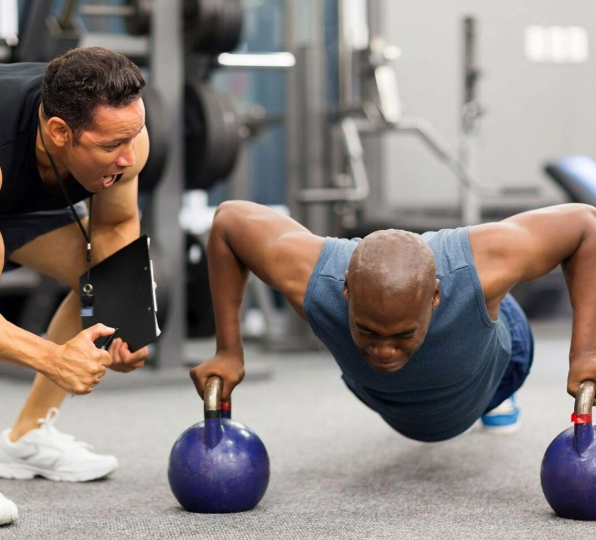Introduction:
Embarking on a fitness journey can be both exhilarating and daunting. To navigate this path effectively, setting clear and achievable fitness goals is paramount. Personal trainers, with their expertise and experience, play a crucial role in guiding individuals towards their fitness aspirations. In this article, we’ll delve into the top 10 fitness goals recommended by personal trainers, offering valuable insights and strategies to help you achieve success on your fitness journey.
1. Weight Loss or Fat Loss Goals
Setting weight loss or fat loss goals can be an empowering and transformative step towards achieving a healthier body composition and improving overall well-being. While weight loss and fat loss are often used interchangeably, they represent distinct processes with different implications for health and fitness. Weight loss refers to a reduction in overall body weight, which can encompass loss of muscle, water, and fat. In contrast, fat loss specifically targets the reduction of body fat while preserving lean muscle mass, resulting in a leaner, more toned physique.
When setting weight loss or fat loss goals, it’s important to focus on sustainable and realistic outcomes that prioritize long-term health and well-being over short-term fixes. This involves establishing specific, measurable, and attainable goals that align with individual preferences, needs, and lifestyle factors. Whether aiming to lose a certain number of pounds, decrease body fat percentage, or achieve a specific clothing size, having clear goals provides motivation and direction for progress.
Furthermore, it’s essential to approach weight loss or fat loss goals holistically, incorporating a balanced combination of nutrition, exercise, sleep, stress management, and mindset strategies. Adopting a nutrient-dense diet rich in whole foods, lean proteins, fruits, vegetables, and healthy fats supports energy balance and promotes fat loss while providing essential nutrients for overall health. Regular physical activity, including strength training, cardiovascular exercise, and flexibility training, helps to boost metabolism, preserve lean muscle mass, and optimize fat burning.
Moreover, prioritizing adequate sleep, managing stress levels, and cultivating a positive mindset are crucial for supporting sustainable behavior change and maintaining motivation throughout the journey. Celebrating progress, no matter how small, and practicing self-compassion and resilience in the face of setbacks can help individuals stay focused and resilient on their weight loss or fat loss journey.
It’s important to remember that weight loss or fat loss is not a one-size-fits-all process, and progress may vary from person to person. Embracing individual differences, listening to your body, and adjusting goals and strategies as needed are key to achieving success and maintaining long-term results.
2. Strength and Muscle Gain Objectives
Setting strength and muscle gain objectives is a proactive and empowering step towards achieving a stronger, more resilient physique and improving overall physical performance. Whether aiming to increase muscle mass, enhance muscular strength, or improve functional fitness, setting clear and realistic objectives provides direction and motivation for progress.
Strength and muscle gain objectives are achieved through a combination of resistance training, proper nutrition, adequate rest, and consistent progressive overload. Resistance training, such as weightlifting, bodyweight exercises, or resistance bands, stimulates muscle growth by creating micro-tears in muscle fibers, which then repair and grow stronger during rest periods. By progressively increasing the intensity, volume, or complexity of resistance exercises over time, individuals can challenge their muscles and stimulate further growth and adaptation.
Proper nutrition plays a crucial role in supporting muscle growth and recovery. Consuming an adequate amount of protein, carbohydrates, and healthy fats provides the building blocks and energy needed for muscle repair and growth. Protein, in particular, is essential for muscle synthesis, and consuming protein-rich foods such as lean meats, fish, eggs, dairy, legumes, and plant-based protein sources can help support muscle gain objectives.
In addition to resistance training and nutrition, adequate rest and recovery are essential for maximizing muscle growth and performance. During rest periods, muscles repair and rebuild stronger, allowing for greater gains in strength and size. Adequate sleep, hydration, and stress management also play important roles in supporting recovery and optimizing muscular adaptation.
3.Improved Cardiovascular Fitness
Improved cardiovascular fitness is a key objective for individuals seeking to enhance their overall health, endurance, and quality of life. Cardiovascular fitness, also known as aerobic fitness, refers to the ability of the cardiovascular system to efficiently deliver oxygen-rich blood to working muscles during prolonged physical activity. By setting goals to improve cardiovascular fitness, individuals can experience a wide range of physical and mental health benefits, including reduced risk of chronic diseases, improved endurance, increased energy levels, and enhanced mood and well-being.
Improving cardiovascular fitness involves engaging in regular aerobic exercise that elevates heart rate and challenges the cardiovascular system. This can include activities such as running, cycling, swimming, brisk walking, dancing, or participating in group fitness classes. The key is to engage in activities that elevate heart rate and challenge the body’s ability to deliver oxygen to working muscles, while also being enjoyable and sustainable for long-term adherence.
Setting specific, measurable, attainable, relevant, and time-bound (SMART) goals is essential for making progress in improving cardiovascular fitness. Whether aiming to increase endurance, decrease resting heart rate, improve performance in a specific activity, or achieve a certain distance or duration, having clear objectives provides focus and motivation for progress.
To improve cardiovascular fitness, individuals can gradually increase the intensity, duration, and frequency of aerobic exercise sessions over time. This progressive overload stimulates adaptations in the cardiovascular system, including increased stroke volume, improved heart efficiency, and enhanced oxygen uptake by the muscles. Incorporating a variety of aerobic activities and cross-training modalities can also help prevent boredom, reduce the risk of overuse injuries, and promote overall fitness and well-being.
4.Flexibility and Mobility Enhancement
Enhancing flexibility and mobility is a valuable goal for individuals seeking to improve physical performance, prevent injuries, and maintain overall well-being. Flexibility refers to the range of motion in a joint or group of joints, while mobility encompasses the ability to move freely and easily through a full range of motion. By setting objectives to improve flexibility and mobility, individuals can experience a wide range of benefits, including reduced muscle stiffness, improved posture, enhanced athletic performance, and increased resilience to injury.
Improving flexibility and mobility involves incorporating a variety of stretching, mobility, and corrective exercises into one’s regular fitness routine. Static stretching, dynamic stretching, foam rolling, yoga, Pilates, and mobility drills are just a few examples of effective techniques for enhancing flexibility and mobility. These exercises target muscles, tendons, ligaments, and fascia, helping to improve tissue elasticity, joint range of motion, and neuromuscular coordination.
Setting specific, measurable, attainable, relevant, and time-bound (SMART) goals is essential for making progress in enhancing flexibility and mobility. Whether aiming to achieve a specific range of motion in a particular joint, improve posture, alleviate muscle tightness, or enhance performance in a specific activity, having clear objectives provides focus and motivation for progress.
To improve flexibility and mobility, individuals can incorporate stretching and mobility exercises into their warm-up, cool-down, and recovery routines. Gradually increasing the duration and intensity of stretching and mobility exercises over time helps stimulate adaptations in the muscles, tendons, and connective tissues, leading to improvements in flexibility and mobility.
5.Injury Rehabilitation and Prevention
Injury rehabilitation and prevention are paramount objectives for individuals recovering from injuries, as well as those seeking to minimize the risk of future injuries and maintain optimal physical function. Whether rehabilitating from a specific injury or proactively addressing underlying imbalances and weaknesses, setting goals to rehabilitate and prevent injuries is essential for promoting long-term health, mobility, and quality of life.
Injury rehabilitation involves a comprehensive approach to restoring function, reducing pain, and promoting healing following an injury. This may include physical therapy, chiropractic care, massage therapy, acupuncture, or other forms of rehabilitative treatment tailored to the individual’s specific needs and condition. Setting specific, measurable, attainable, relevant, and time-bound (SMART) goals in collaboration with healthcare professionals helps guide the rehabilitation process and track progress towards recovery milestones.
Preventing injuries involves identifying and addressing risk factors, improving movement patterns and biomechanics, and implementing strategies to enhance resilience and durability. This may include strength training, flexibility and mobility exercises, balance and coordination drills, and corrective movement patterns aimed at addressing muscular imbalances, weaknesses, and movement dysfunctions. Setting goals to improve strength, flexibility, balance, and proprioception helps individuals build a foundation of resilience and reduce the likelihood of injury during physical activity.
Injury rehabilitation and prevention goals may vary depending on the individual’s specific circumstances, injury history, and activity level. Whether rehabilitating from a sports injury, recovering from surgery, or seeking to prevent overuse injuries associated with repetitive movement patterns, having clear objectives provides focus and motivation for progress.
Incorporating a well-rounded approach to injury rehabilitation and prevention involves addressing not only physical factors but also psychological and lifestyle factors that may impact recovery and injury risk. Proper nutrition, hydration, sleep, stress management, and mindset strategies play crucial roles in supporting tissue healing, optimizing physical function, and enhancing overall well-being.
6. Stress Reduction and Mental Well-being
Stress reduction and mental well-being are essential objectives for individuals seeking to cultivate greater resilience, balance, and overall quality of life in today’s fast-paced and demanding world. Chronic stress and mental health issues such as anxiety, depression, and burnout can have profound effects on physical health, emotional well-being, and interpersonal relationships. By setting goals to reduce stress and enhance mental well-being, individuals can take proactive steps to manage stressors, improve coping skills, and foster greater emotional and psychological resilience.
Stress reduction involves identifying sources of stress and implementing strategies to mitigate their impact on daily life. This may include practicing relaxation techniques such as deep breathing, meditation, mindfulness, or progressive muscle relaxation to calm the mind and body and promote a sense of inner peace and tranquility. Setting specific, measurable, attainable, relevant, and time-bound (SMART) goals for stress reduction helps individuals identify areas for improvement and track progress towards achieving greater balance and well-being.
In addition to relaxation techniques, incorporating lifestyle changes such as regular exercise, adequate sleep, healthy nutrition, and time management strategies can help reduce stress levels and enhance overall well-being. Regular physical activity helps release tension, improve mood, and promote relaxation, while proper nutrition supports optimal brain function and emotional regulation. Setting goals to prioritize self-care and establish healthy habits supports long-term stress reduction and mental well-being.
Enhancing mental well-being involves cultivating positive emotions, nurturing social connections, and building resilience to life’s challenges. This may include practicing gratitude, engaging in activities that bring joy and fulfillment, and fostering meaningful relationships with family, friends, and community. Setting goals to cultivate gratitude, foster connections, and build resilience helps individuals develop a more positive outlook on life and navigate adversity with greater ease and resilience.
7. Improved Posture and Body Alignment
Improved posture and body alignment are essential objectives for individuals seeking to alleviate pain, reduce the risk of injuries, and enhance overall physical function and appearance. Good posture and proper body alignment promote optimal biomechanics, spinal health, and muscular balance, leading to improved stability, mobility, and energy efficiency during movement. By setting goals to improve posture and body alignment, individuals can address imbalances, correct faulty movement patterns, and cultivate greater resilience and vitality in everyday life.
Improving posture involves aligning the body’s skeletal structure in a way that minimizes stress on joints, muscles, and ligaments, while promoting optimal function and efficiency. This may include addressing common postural deviations such as forward head posture, rounded shoulders, excessive thoracic kyphosis, anterior pelvic tilt, or hyperextended knees. Setting specific, measurable, attainable, relevant, and time-bound (SMART) goals for posture improvement helps individuals identify areas for correction and track progress towards achieving better alignment and posture.
To improve posture and body alignment, individuals can incorporate a variety of corrective exercises, stretching routines, and ergonomic adjustments into their daily routine. This may include strengthening exercises for weak muscles, stretching exercises for tight muscles, and mobility drills to improve joint mobility and range of motion. Additionally, practicing proper body mechanics and ergonomics during daily activities such as sitting, standing, walking, and lifting helps reinforce good posture habits and prevent postural imbalances.
In addition to physical exercises and adjustments, cultivating body awareness, mindfulness, and self-care practices can further support improved posture and body alignment. Mind-body practices such as yoga, Pilates, tai chi, and mindfulness meditation promote awareness of body sensations, alignment, and movement patterns, helping individuals develop a more conscious and intentional relationship with their bodies. Setting goals to incorporate these practices into daily life supports long-term postural improvement and overall well-being.
8. Enhanced Sports Performance
Enhanced sports performance is a crucial objective for athletes and individuals involved in competitive or recreational sports, as it directly impacts athletic success, skill execution, and overall enjoyment of physical activities. By setting goals to improve sports performance, athletes can enhance their physical capabilities, optimize their training, and maximize their potential for success in their chosen sport or activity.
Improving sports performance involves a multifaceted approach that encompasses various aspects of physical fitness, skill development, mental preparation, and strategic planning. Setting specific, measurable, attainable, relevant, and time-bound (SMART) goals for sports performance improvement helps athletes identify areas for development and track progress towards achieving peak performance levels.
Physical conditioning plays a fundamental role in enhancing sports performance, as it directly affects strength, power, speed, agility, endurance, and overall athleticism. Setting goals to improve specific physical attributes such as strength, speed, or endurance helps athletes tailor their training programs to address areas of weakness and capitalize on their strengths. This may include strength training, plyometric exercises, sprint drills, agility drills, cardiovascular conditioning, and flexibility training, among other modalities.
Skill development is another critical component of sports performance improvement, as it directly influences technique, coordination, precision, and efficiency in executing sport-specific movements and maneuvers. Setting goals to improve technical skills, tactical awareness, and decision-making abilities helps athletes refine their techniques, enhance their game intelligence, and elevate their performance levels on the field, court, or track.
9. Nutrition and Dietary Goals
Nutrition and dietary goals are fundamental objectives for individuals seeking to optimize their health, energy levels, and overall well-being through proper nourishment and dietary habits. By setting goals to improve nutrition, individuals can make informed choices about their diet, enhance nutrient intake, and establish sustainable eating patterns that support long-term health and vitality.
Improving nutrition involves adopting a balanced and nutrient-dense diet that provides essential nutrients, vitamins, and minerals necessary for optimal bodily function and performance. Setting specific, measurable, attainable, relevant, and time-bound (SMART) goals for nutrition helps individuals identify areas for improvement and track progress towards achieving dietary objectives.
One common nutrition goal is to increase the consumption of whole, minimally processed foods such as fruits, vegetables, whole grains, lean proteins, and healthy fats. These nutrient-rich foods provide essential nutrients, fiber, and antioxidants that support overall health, reduce the risk of chronic diseases, and promote longevity.
Another important nutrition goal is to limit the intake of processed foods, refined sugars, unhealthy fats, and artificial additives that provide empty calories and contribute to poor health outcomes. Setting goals to reduce consumption of sugary beverages, refined carbohydrates, and highly processed snacks helps individuals improve their dietary quality and make healthier choices.
10. Consistency and Accountability
Consistency and accountability are fundamental principles for achieving success in any endeavor, including personal growth, health and fitness, career advancement, and goal attainment. By setting goals to prioritize consistency and accountability, individuals can establish positive habits, stay focused on their objectives, and take ownership of their actions and outcomes.
Consistency involves committing to regular, disciplined effort towards achieving desired goals and outcomes over time. It entails showing up consistently, putting in the necessary work, and persisting in the face of challenges or setbacks. Setting specific, measurable, attainable, relevant, and time-bound (SMART) goals for consistency helps individuals establish clear expectations and benchmarks for progress.
Accountability involves taking responsibility for one’s actions, decisions, and commitments, and being answerable to oneself and others for meeting expectations and achieving desired outcomes. It entails holding oneself to high standards of integrity, discipline, and performance, and being willing to be transparent and honest about one’s progress and challenges. Setting goals for accountability helps individuals stay focused, motivated, and on track towards achieving their goals.
One effective strategy for fostering consistency and accountability is to establish routines, systems, and habits that support goal attainment. This may include creating a daily or weekly schedule, setting reminders and deadlines, tracking progress, and reviewing goals regularly to stay on course. Additionally, enlisting the support of a mentor, coach, or accountability partner can provide external accountability and encouragement to help individuals stay committed and accountable to their goals.


Conclusion:
Setting and achieving fitness goals is a journey that requires dedication, perseverance, and support. By aligning with the recommendations of personal trainers and setting S.M.A.R.T. goals, individuals can embark on a transformative fitness journey that yields tangible results. Whether aiming for weight loss, strength gains, or improved overall health, personal trainers offer valuable expertise and guidance to help individuals overcome obstacles, stay motivated, and achieve their fitness aspirations. So, empower yourself with the guidance of a personal trainer and take proactive steps towards realizing your fitness goals and unlocking your full potential.












